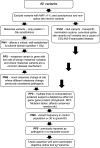Prevalence Estimates of Predicted Pathogenic COL4A3-COL4A5 Variants in a Population Sequencing Database and Their Implications for Alport Syndrome
- PMID: 34400539
- PMCID: PMC8729840
- DOI: 10.1681/ASN.2020071065
Prevalence Estimates of Predicted Pathogenic COL4A3-COL4A5 Variants in a Population Sequencing Database and Their Implications for Alport Syndrome
Abstract
Background: The reported prevalence of Alport syndrome varies from one in 5000 to one in 53,000 individuals. This study estimated the frequencies of predicted pathogenic COL4A3-COL4A5 variants in sequencing databases of populations without known kidney disease.
Methods: Predicted pathogenic variants were identified using filtering steps based on the ACMG/AMP criteria, which considered collagen IV α3-α5 position 1 Gly to be critical domains. The population frequencies of predicted pathogenic COL4A3-COL4A5 variants were then determined per mean number of sequenced alleles. Population frequencies for compound heterozygous and digenic combinations were calculated from the results for heterozygous variants.
Results: COL4A3-COL4A5 variants resulting in position 1 Gly substitutions were confirmed to be associated with hematuria (for each, P<0.001). Predicted pathogenic COL4A5 variants were found in at least one in 2320 individuals. p.(Gly624Asp) represented nearly half (16 of 33, 48%) of the variants in Europeans. Most COL4A5 variants (54 of 59, 92%) had a biochemical feature that potentially mitigated the clinical effect. The predicted pathogenic heterozygous COL4A3 and COL4A4 variants affected one in 106 of the population, consistent with the finding of thin basement membrane nephropathy in normal donor kidney biopsy specimens. Predicted pathogenic compound heterozygous variants occurred in one in 88,866 individuals, and digenic variants in at least one in 44,793.
Conclusions: The population frequencies for Alport syndrome are suggested by the frequencies of predicted pathogenic COL4A3-COL4A5 variants, but must be adjusted for the disease penetrance of individual variants and for the likelihood of already diagnosed disease and non-Gly substitutions. Disease penetrance may depend on other genetic and environmental factors.
Keywords: Alport syndrome; COL4A3; COL4A4; COL4A5; Gly substitutions; collagen IV; genetic renal disease; glomerular basement membrane; hematuria; thin basement membrane nephropathy.
Copyright © 2021 by the American Society of Nephrology.
Figures


References
-
- Gubler M, Levy M, Broyer M, Naizot C, Gonzales G, Perrin D, et al. : Alport’s syndrome. A report of 58 cases and a review of the literature. Am J Med 70: 493–505, 1981 - PubMed
-
- Barker DF, Hostikka SL, Zhou J, Chow LT, Oliphant AR, Gerken SC, et al. : Identification of mutations in the COL4A5 collagen gene in Alport syndrome. Science 248: 1224–1227, 1990 - PubMed
-
- Mochizuki T, Lemmink HH, Mariyama M, Antignac C, Gubler MC, Pirson Y, et al. : Identification of mutations in the alpha 3(IV) and alpha 4(IV) collagen genes in autosomal recessive Alport syndrome. Nat Genet 8: 77–81, 1994 - PubMed
-
- Buzza M, Wilson D, Savige J: Segregation of hematuria in thin basement membrane disease with haplotypes at the loci for Alport syndrome. Kidney Int 59: 1670–1676, 2001 - PubMed
-
- Buzza M, Dagher H, Wang YY, Wilson D, Babon JJ, Cotton RG, et al. : Mutations in the COL4A4 gene in thin basement membrane disease. Kidney Int 63: 447–453, 2003 - PubMed
Publication types
MeSH terms
Substances
Grants and funding
- UC2 HL103010/HL/NHLBI NIH HHS/United States
- RC2 HL102926/HL/NHLBI NIH HHS/United States
- DH_/Department of Health/United Kingdom
- RC2 HL102924/HL/NHLBI NIH HHS/United States
- MR/S021329/1/MRC_/Medical Research Council/United Kingdom
- RC2 HL102923/HL/NHLBI NIH HHS/United States
- UC2 HL102926/HL/NHLBI NIH HHS/United States
- UC2 HL102923/HL/NHLBI NIH HHS/United States
- UC2 HL102924/HL/NHLBI NIH HHS/United States
- RC2 HL103010/HL/NHLBI NIH HHS/United States
- WT_/Wellcome Trust/United Kingdom
- RC2 HL102925/HL/NHLBI NIH HHS/United States
- UC2 HL102925/HL/NHLBI NIH HHS/United States
- CRUK_/Cancer Research UK/United Kingdom
LinkOut - more resources
Full Text Sources
Medical

